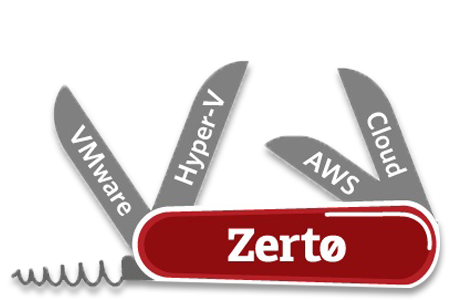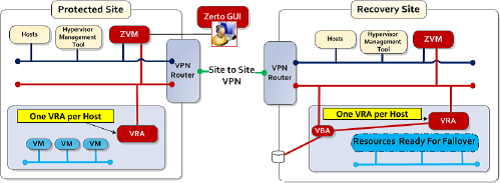Zerto Virtual Replication provides a business continuity (BC) and disaster recovery (DR) solution in a virtual environment, providing near real-time replication, with write-order fidelity, with minimal impact on product workloads. Fully automated orchestration delivers failover, failback, and reverse protection in one click. Non-disruptive disaster recovery testing gives you confidence that your DR solution will work predictably and consistently. Consistency groups ensure all virtual machines that comprise an application are protected in the exact same manner no matter where they are in the environment.
With support for different hypervisors, such as vSphere or Hyper-V, workloads can be protected, migrated, and recovered, either within the same hypervisor environment or across hypervisor environments.
Zerto Virtual Replication is installed in both the protected and the recovery sites. and the disaster recovery across these sites is managed by a browser-based user interface. Managing tZerto Virtual Replication is also possible programmatically, either via a set of RESTful APIs or PowerShell cmdlets.
Recovery that does rely on native replication functionality, such as recovery available with Microsoft Active Directory or SQL Server, can also be replicated using Zerto Virtual Replication, and whether the native replication functionality is used or not is determined by site considerations, such as increased complexity of having multiple points of control and possible additional costs incurred when using vendor native replication.
You configure replication by first pairing the site with virtual machines to be protected with a recovery site. You then define what virtual machines you want replicated in consistency groups, where the virtual machines in a group comprise the application and data you want to protect. You can group different virtual machines together or keep them separate. By creating different replication groups, you can customize the replication requirements for each group to better optimize the recovery plan.
Disaster recovery is based on the premise that you will want to recover with a minimum RPO. However, to enable full recovery in cases such as virus attacks, Zerto Virtual Replication provides the ability to recover to a point in time up to 14 days prior to the disaster. When recovery earlier than 14 days is required, Zerto Virtual Replication provides an extended recovery, using an offsite backup mechanism that enables you to recover to a recovery site based on a daily or weekly backup going as far back as a year. The majority of the processing for both disaster recovery and extended recovery is done at the recovery site, minimizing the impact on the production site.
Zerto Virtual Replication Architecture
Zerto Virtual Replication provides disaster recovery between hypervisors such as VMware ESX/ESXi hosts managed by vCenter Servers and Microsoft Hyper-V hosts managed by SCVMM. In addition, you can protect virtual machines in these environments to a public cloud, such as Amazon Web Services.
When Zerto Virtual Replication is installed to work with a hypervisor it comprises the following components:
Zerto Virtual Manager (ZVM) – A Windows service that manages everything required for the replication between the protection and recovery sites, except for the actual replication of data. The ZVM interacts with the hypervisor management user interface, such as vCenter Server or Microsoft SCVMM, to get the inventory of VMs, disks, networks, hosts, etc. and then the Zerto User Interface manages this protection. The ZVM also monitors changes in the hypervisor environment and responds accordingly. For example, a VMware vMotion operation, or Microsoft Live Migration of a protected VM from one host to another is intercepted by the ZVM and the Zerto User Interface is updated accordingly.
A Zerto Virtual Manager can manage up to 5000 virtual machines, either being protected by, or recovered to, the Zerto Virtual Manager.
Virtual Replication Appliance (VRA) – A virtual machine installed on each hypervisor hosting virtual machines to be protected or recovered, to manage the replication of data from protected virtual machines to the recovery site.
A VRA can manage a maximum of 1500 volumes, whether these are volumes being protected or recovered.
Virtual Backup Appliance (VBA) – A VBA is a Windows service, which manages back-ups within Zerto Virtual Replication. The VBA service runs on the same machine as the Zerto Virtual Manager service and is responsible for the repositories where offsite backups are stored. These repositories can be local or on a shared network.
Zerto User Interface – Recovery using Zerto Virtual Replication is managed in a browser.
The following diagram shows how the main Zerto Virtual Replication components are deployed across hypervisor-based enterprise sites to provide disaster recovery across these sites.
When you plan to recover the enterprise site to a public cloud, Zerto Virtual Replication is installed in the cloud environment. Zerto Virtual Replication comprises the same components but the VRA runs as a service, so that the ZVM, VRA, and VBA all run as services on a single virtual machine instance in the public cloud.
How Zerto Virtual Replication Recovery Works
Installing Zerto Virtual Replication installs the Zerto Virtual Manager, which sits in the hypervisor layer on the enterprise site. You manage the Zerto Virtual Manager, one on each of the protected and recovery sites, using the Zerto User Interface.
Zerto also provides a set of RESTful APIs and PowerShell cmdlets to enable incorporating some of the disaster recovery functionality within scripts or programs.
In the protected site you define the virtual machines that you want to replicate, either individually or together, as a virtual protection group (VPG). The virtual machines that you include in the VPG can come from one or more hypervisor hosts. In this way, you can protect applications that run on multiple virtual machines and disks as a single unit – a VPG. An example of an application that runs on multiple virtual machines includes software that requires a web server and database, both of which run on virtual machines different than the virtual machine where the application software runs.
Every write is copied by Zerto Virtual Replication and sent, asynchronously, to the recovery site, while the write continues to be processed on the protected site. For greater efficiency and performance, the write can be compressed before being sent to the recovery site with throttling techniques being used to prioritize network traffic.
On the recovery site the write is written to a journal managed by a Virtual Replication Appliance (VRA). Each protected virtual machine has its own journal. Every few seconds, a checkpoint is also written to each journal. These checkpoints ensure write order fidelity and crash-consistency to each checkpoint. During recovery you pick one of these crash-consistent checkpoints and recover to this point. Additionally, checkpoints can be manually added by the administrator, with a description of the checkpoint. For example, when an event is going to take place that might result in the need to perform a recovery, you can pinpoint when this event occurs as a checkpoint written to each journal.
The VRA manages the journals for every virtual machine that will be recovered to the hypervisor hosting that VRA. It also manages images of the protected volumes for these virtual machines. During a failover, you can specify that you want to recover the virtual machines in the VPG using the last checkpoint or you can specify an earlier checkpoint, in which case the recovery of the mirror images under the VRA are synchronized to this checkpoint. Thus, you can recover the environment to the point before any corruption and ignore later writes in the journal that were corrupted, regardless of the cause of the corruption, such as a crash in the protected site or a virus attack.
To improve the RTO during recovery, the user is able to start working even before the virtual machine volumes on the recovery site have been fully synchronized. Every request is analyzed and the response returned either from the virtual machine directly or from the journal if the information in the journal is more up-to-date. This continues until the recovery site virtual environment is fully synchronized, up until the last checkpoint or an earlier checkpoint, when the integrity of the protected site was assured.
When recovery to a point is required that is further in the past than the time saved in the journal, an offsite backup can be restored. Offsite backups are an extension of disaster recovery, with the virtual machine files, such as the configuration and virtual disk files, saved to a repository for up to one year. These files are then used to restore the virtual machines to the point of the stored offsite backup at the recovery site.
Benefits of Using Zerto Virtual Replication
Datacenter optimization and virtualization technologies have matured and are now commonly used in IT infrastructure. As more applications are deployed in a virtualized infrastructure, there is a growing need for recovery mechanisms that support mission critical application deployments while providing complete BC and DR.
Traditional replication and disaster recovery solutions were not conceived to deal with the demands created by the virtualization paradigm. For example, most replication solutions are not managed in the hypervisor layer, considering the virtual machines and disks, but at the physical disk level. Hence they are not truly virtualization aware.
The lack of virtualization awareness creates a huge operational and administrative burden. It also results in operational inflexibility. Zerto Virtual Replication has been designed to resolve these issues by being fully virtualization aware.
Fully Virtual – Sits in the Hypervisor
Zerto Virtual Replication software sits in the hypervisor level. Protection groups are configured with virtual machines and virtual disks, without the need to consider the physical disks.
Hypervisor Agnostic
Zerto Virtual Replication runs both in VMware vCenter Server and Microsoft SCVMM. It is compatible with VMware hypervisor management features, such as vMotion and Microsoft hypervisor management features, such as Live Migration.
Hardware Agnostic
Because Zerto Virtual Replication software manages recovery of virtual machines and virtual disks only, it does not matter what hardware is used in either the protected or recovery sites; it can be from the same vendor or different vendors. With Zerto Virtual Replication the logical storage is separated from the physical storage so that the vendor and actual type of storage hardware do not need to be considered.
Zerto Virtual Replication provides a workload mobility and protection layer providing seamless connectivity, portability, protection, orchestration, and application encapsulation of workloads across clouds without vendor lock-in. High scale, mission critical applications, and data are encapsulated, as well as features, specifications, and configurations, and can be seamlessly migrated across different servers, storage, hypervisors, and clouds without any disruption to business services.
With Zerto Virtual Replication, IT managers can choose the right infrastructure for the right use case for the right price. One application can leverage several different environments for disaster recovery, bursting, production, backup, testing, and development. With Zerto Virtual Replication there is no vendor lock-in to a cloud, technology, or vendor. Any choice, any cloud, any technology, any price, any service level is available in minutes for any workload.
Focus is on the Application, Not the Physical Storage
By considering the physical disk level and not the virtual disk level, traditional replication is not truly application aware. Even virtual replication recovers block writes at the SCSI level and not at the application level. Zerto Virtual Replication is truly application focused, replicating the writes from the application in a consistent manner.
Compatibility Across Virtual Environments
Zerto Virtual Replication enables replication across multiple hypervisor managers, such as VMware vCenter Server and Microsoft SCVMM, and to public clouds such as Amazon Web Services (AWS).
Fully Scalable
Zerto Virtual Replication enables defining software-only Virtual Replication Appliances (VRAs) on each hypervisor host to manage the replication of virtual machines on that host. Increasing the number of hypervisor hosts is handled by defining a new VRA on each new host. There is no need to install additional software to the hypervisor management tool, such as VMware vCenter Server or Microsoft SCVMM, to handle additional hosts or virtual machines and no need to consider additional hardware acquisitions.
Efficient Asynchronous Replication
Writes are captured by the Zerto Virtual Replication software in the hypervisor level, before they are written to the physical disk at the protected site. These writes are sent to the recovery site asynchronously, thus avoiding long distance replication latency for the production applications.
Also, because these writes are captured and sent to the recovery site, it is only the delta changes and not the whole file or disk that is sent to the recovery site, reducing the amount of network traffic, which reduces WAN requirements and significantly improves the ability to meet both RPO and RTO targets.
One-Click Failover and Control of the Recovery Process
When recovery is required, the administrator clicks on a button in the Zerto User Interface to initiate failover. This means that controlling the start of a recovery remains in the hands of the administrator, who can decide when to initiate the recovery and, by selecting a checkpoint, to what point-in-time to recover to.
One-Click Migration
Application migrations can be resource intensive projects that take weeks of planning, execution, and downtime. With Zerto Virtual Replication migrations are greatly simplified and can be completed without extended outages or maintenance windows and across different types of hardware and even different hypervisors, such as VMware ESXi or Microsoft Hyper-V. Migrations across different versions within a type of hypervisor, such as from a VMware vCenter environment to a vCloud environment or even cross hypervisor migration, such as migration from a vCenter environment to a Hyper-V environment is as easy as a migration from one site to another using the same hypervisor infrastructure.
Offsite Backup
Zerto Virtual Replication provides an offsite back up option that enables saving the protected virtual machines offsite for up to one year in a state where they can be easily deployed. Because the backups use the same mechanism used for disaster recovery, the performance impact on the production site is minimal, since the processing is performed on the recovery site. The offsite backups are fixed points saved either weekly or monthly.
Policy-based
In the protected site you define the virtual machines that you want to recover, either individually or as groups, as a virtual protection group (VPG). The virtual machines that you include in the VPG can come from one or more hypervisor hosts. In this way, you can protect applications that run on multiple virtual machines and disks as a single unit, in a single VPG.
Minimal RPO
Zerto Virtual Replication utilizes continuous data protection, sending a record of every write in the virtual protection group to the recovery site. The transfer of this information is done over an optimized WAN asynchronously. If recovery is required, all the data that was transferred to the recovery site is available resulting in recovery within the requested RPO.
WAN Resilience on Both the Protected and Recovery Sites
Zerto Virtual Replication is highly resilient to WAN interruptions. In order to reduce storage overhead used for replication purposes, on WAN failure or when the load over the WAN is too great for the WAN to handle, Zerto Virtual Replication starts to maintain a smart bitmap in memory, in which it tracks and records the storage areas that changed. Since the bitmap is kept in memory, Zerto Virtual Replication does not require any LUN or volume per VPG at the protected side. The bitmap is small and scales dynamically, but does not contain any actual IO data, just references to the areas of the protected disk that have changed. The bitmap is stored locally on the VRA within the available resources. Once the WAN connection resumes or the load returns to normal traffic, Zerto Virtual Replication uses this bitmap to check whether there were updates to the protected disks and if there were updates to the disks, these updates are sent to the recovery site.
DR Management Anywhere
With Zerto Virtual Replication everything is managed from a standalone browser-base user interface, enabling disaster recovery management from anywhere using any device.









Leave a Comment